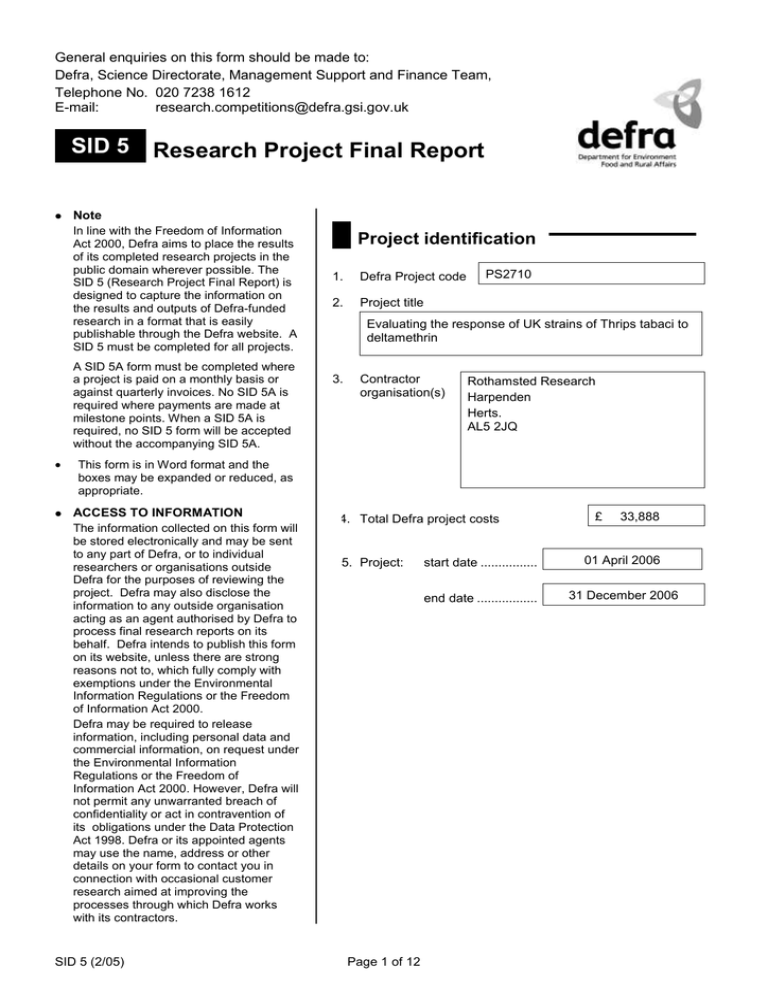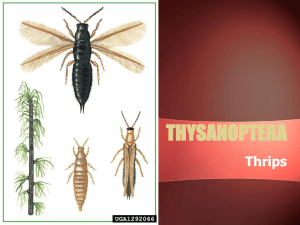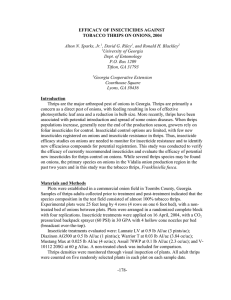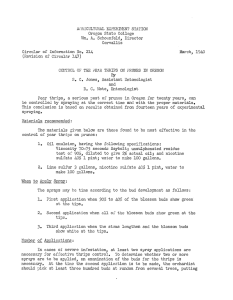Document 13200327
advertisement

General enquiries on this form should be made to: Defra, Science Directorate, Management Support and Finance Team, Telephone No. 020 7238 1612 E-mail: research.competitions@defra.gsi.gov.uk SID 5 Research Project Final Report Note In line with the Freedom of Information Act 2000, Defra aims to place the results of its completed research projects in the public domain wherever possible. The SID 5 (Research Project Final Report) is designed to capture the information on the results and outputs of Defra-funded research in a format that is easily publishable through the Defra website. A SID 5 must be completed for all projects. A SID 5A form must be completed where a project is paid on a monthly basis or against quarterly invoices. No SID 5A is required where payments are made at milestone points. When a SID 5A is required, no SID 5 form will be accepted without the accompanying SID 5A. This form is in Word format and the boxes may be expanded or reduced, as appropriate. ACCESS TO INFORMATION The information collected on this form will be stored electronically and may be sent to any part of Defra, or to individual researchers or organisations outside Defra for the purposes of reviewing the project. Defra may also disclose the information to any outside organisation acting as an agent authorised by Defra to process final research reports on its behalf. Defra intends to publish this form on its website, unless there are strong reasons not to, which fully comply with exemptions under the Environmental Information Regulations or the Freedom of Information Act 2000. Defra may be required to release information, including personal data and commercial information, on request under the Environmental Information Regulations or the Freedom of Information Act 2000. However, Defra will not permit any unwarranted breach of confidentiality or act in contravention of its obligations under the Data Protection Act 1998. Defra or its appointed agents may use the name, address or other details on your form to contact you in connection with occasional customer research aimed at improving the processes through which Defra works with its contractors. SID 5 (2/05) Project identification 1. Defra Project code 2. Project title PS2710 Evaluating the response of UK strains of Thrips tabaci to deltamethrin 3. Contractor organisation(s) Rothamsted Research Harpenden Herts. AL5 2JQ 54. Total Defra project costs 5. Project: Page 1 of 12 £ 33,888 start date ................ 01 April 2006 end date ................. 31 December 2006 6. It is Defra’s intention to publish this form. Please confirm your agreement to do so. ................................................................................... YES NO (a) When preparing SID 5s contractors should bear in mind that Defra intends that they be made public. They should be written in a clear and concise manner and represent a full account of the research project which someone not closely associated with the project can follow. Defra recognises that in a small minority of cases there may be information, such as intellectual property or commercially confidential data, used in or generated by the research project, which should not be disclosed. In these cases, such information should be detailed in a separate annex (not to be published) so that the SID 5 can be placed in the public domain. Where it is impossible to complete the Final Report without including references to any sensitive or confidential data, the information should be included and section (b) completed. NB: only in exceptional circumstances will Defra expect contractors to give a "No" answer. In all cases, reasons for withholding information must be fully in line with exemptions under the Environmental Information Regulations or the Freedom of Information Act 2000. (b) If you have answered NO, please explain why the Final report should not be released into public domain Executive Summary 7. The executive summary must not exceed 2 sides in total of A4 and should be understandable to the intelligent non-scientist. It should cover the main objectives, methods and findings of the research, together with any other significant events and options for new work. 1) Onion thrips, Thrips tabaci, is a prevalent pest of many cultivated crops throughout Europe and various other parts of the world. It infests glasshouse and field vegetables such as leeks and salad onions, and primarily causes direct feeding damage that disfigures the leaves. Pesticides are the main option for control but this approach is challenging due to problems with delivery and contacting thrips. There is also the risk of insecticide resistance developing, illustrated by widespread loss of control with organophosphates since the early 1990s. 2) There are anecdotal reports that poor efficacy of pyrethroids against UK T. tabaci may, in part, be a consequence of resistance. Resistance to this class of chemicals has been confirmed in other parts of the world, eg. to deltamethrin in New Zealand, to lambda-cyhalothrin in the USA and to cypermethrin in Nicaragua. However, in general there is much less known about this phenomenon in T. tabaci than in the closely-related species Western flower thrips, Frankliniella occidentalis. 3) The purpose of the work was to provide information on the response of contemporary UK strains of T. tabaci to deltamethrin to assess the level and prevalence of resistance, which could then be used as a basis for informing the approval of new compounds and the development of management strategies utilising all the chemical classes available. The work ran for 9 months, providing time to complete three main objectives: (i) validate and refine the bioassay method; (ii) obtain and quantify the responses of UK samples to a range of concentrations of deltamethrin; and (iii) analyse data and prepare a final report. 4) Procedures for culturing, handling and testing samples of T. tabaci followed those developed in New Zealand by Dr Nicolas Martin and colleagues. This allowed the response of UK samples to deltamethrin to be compared directly with data for New Zealand ones. This approach is particularly valuable when there is no proven baseline susceptible strain against which data from field samples can be compared. 5) Live samples of T. tabaci were collected from leeks or salad onions at seven sites in England from May to August 2006 (Figure 1). They were transported to Rothamsted accompanied by records of host plant, place and date of origin and any insecticide treatment history. SID 5 (2/05) Page 2 of 12 6) Samples were reared in glass jars containing tubular segments of organically-grown leeks at 25oC under a 16/8 light/dark photoperiod. New plant material was added every 2-3 days. Generation time (adult to adult) was approximately three weeks. 7) Bioassays used discs cut from the white part of organically-grown leeks. Each disc was dipped into a solution of deltamethrin and allowed to dry in a fume hood. Adult thrips were placed in 50 mm diameter plastic Petri dishes containing one leek disc. Petri-dishes were stored at 25oC under a 16/8 h light/dark photoperiod and responses were assessed after 24 h. 8) Initial bioassays used two samples that had not previously been exposed to insecticides. These showed comparable dose-response relationships to ones confirmed as resistant in New Zealand. Consequently, all 10 UK samples were exposed to a wide range of deltamethrin concentrations rather than just three diagnostic concentrations (as originally proposed). Data were subjected to probit analysis for statistical comparisons of concentration-response relationships. 9) All UK samples showed levels of resistance to deltamethrin comparable or only slightly lower than the maximum level reported from New Zealand. Unlike in the New Zealand study, no deltamethrin-susceptible samples were found. The resistance mechanism(s) are unknown at present but are likely to extend to other synthetic pyrethroids approved for thrips control. As a result, we conclude that these compounds are unlikely to give satisfactory control of this pest in this country. 10) Results were disseminated through contact with Defra-PSD and IRAG-UK and an article in December’s issue of Herb News. A summary of the results was distributed by email to advisors and leek and salad onion growers (in November 2006). Also, an ‘established problem for resistance to pyrethroids in Thrips tabaci’ has been added to the IRAG Pest Resistance Matrix (collated by Bill Parker at ADAS). The work complements an ongoing Defra-funded project at HRI-Warwick on the phenology, dynamics and management of T. tabaci (HH3116 TFV). Project Report to Defra 8. As a guide this report should be no longer than 20 sides of A4. This report is to provide Defra with details of the outputs of the research project for internal purposes; to meet the terms of the contract; and to allow Defra to publish details of the outputs to meet Environmental Information Regulation or Freedom of Information obligations. This short report to Defra does not preclude contractors from also seeking to publish a full, formal scientific report/paper in an appropriate scientific or other journal/publication. Indeed, Defra actively encourages such publications as part of the contract terms. The report to Defra should include: the scientific objectives as set out in the contract; the extent to which the objectives set out in the contract have been met; details of methods used and the results obtained, including statistical analysis (if appropriate); a discussion of the results and their reliability; the main implications of the findings; possible future work; and any action resulting from the research (e.g. IP, Knowledge Transfer). SID 5 (2/05) Page 3 of 12 1. Background Onion thrips, Thrips tabaci, is a prevalent, polyphagous pest of many cultivated crops throughout Europe and various other parts of the world. It infests glasshouse and field vegetables such as leeks and salad onions, and primarily causes direct feeding damage that disfigures the leaves. Pesticides are the main option for control but this approach is challenging due to delivery/contact problems. There is also the risk of resistance developing, illustrated by widespread loss of control with organophosphates since the early 1990s. Furthermore, there are anecdotal reports that poor efficacy of pyrethroids against UK T. tabaci may, in part, be a consequence of the evolution of resistance. Resistance has been confirmed to deltamethrin in New Zealand (Martin et al., 2003), to lambda-cyhalothrin in the USA (Shelton et al., 2003) and to cypermethrin in Nicaragua (Rueda & Shelton, 2003) However, in general there is much less known about this phenomenon in T. tabaci than in the closely-related and highly polyphagous species Western flower thrips, Frankliniella occidentalis. 2. Scientific objectives The purpose of the work was to provide information on the response of contemporary UK strains of T. tabaci to deltamethrin as a basis for informing the approval of new compounds and the development of management strategies utilising all the chemical classes available. The work complemented an ongoing Defra-funded project at HRI-Warwick on the phenology, dynamics and management of T. tabaci (HH3116 TFV). The work ran for 9 months, providing time to refine the bioassay method and quantify the responses of field-collected strains to diagnostic doses of deltamethrin. The project had three major objectives, all of which were either successfully met or exceeded. Objective 1: Validate bioassay and establish diagnostic concentrations Initially, an untreated strain of T. tabaci currently being maintained in a glasshouse at HRIWarwick will be established in culture at Rothamsted and used to validate the bioassay procedure published by Martin et al. (2003). It is intended that all rearing and testing will be done on organically grown leeks (Allium porrum) purchased from a local supermarket. This will preclude any requirement to culture plants at Rothamsted. Insects will be reared on tubular sections of leek in thrips-proof containers, and maintained at 25°C in a 16h light: 8 h dark photoperiod regime. For bioassays, leaf discs cut from leek plants will be dipped into aqueous solutions of deltamethrin and placed into Petri-dishes. Ten adult thrips will be placed in each dish and mortality recorded after 24 h at 25°C. Each concentration will be replicated at least three times. Initial bioassays will establish the concentration-response relationship for the HRI strain, and based on probit analysis three diagnostic concentrations of deltamethrin (equating approximately with the LC50, LC90 and 5 x LC90 of the lab strain) will be identified for monitoring of field samples. Amendment: instead of using diagnostic concentrations, a full range of insecticide concentrations were applied to each strain. The resulting larger data sets allowed the calculation of probit lines and LC50 values. This altered approach was necessary because a deltamethrinsusceptible strain was not found and therefore an initial calculation of diagnostic concentrations to be applied to subsequent UK samples could not be made. Objective 2: Collection and testing of field strains Between June and October 2006, at least 10-12 samples will be obtained from commerciallygrown crops of leeks (and possibly salad onions) identified in consultation with HRI and HDC, transferred to Rothamsted, and reared for one generation to provide uniformly-aged adults for SID 5 (2/05) Page 4 of 12 bioassays. Laboratory rearing will not only overcome the likely substantial differences in age of field-caught insects, but will also preclude the possibility of insects having been exposed to insecticides or other crop protection agents prior to testing. At least three batches of ten insects will be used for each concentration (plus untreated controls) for each sample. Bioassays showing greater than 20% mortality will be repeated until control mortality is within acceptable limits. Amendment: some strains were reared for more than one generation in order to obtain sufficient numbers for bioassays. Objective 3: Analysis and presentation of data Probit- or arcsin-transformed mortality data will be subjected to analyses of variance to quantify the extent of heterogeneity in response between samples and to compare these data to ones for the HRI ‘standard’. Since our bioassay method is designed to reproduce accurately that adopted by Martin et al. (2003), data published by the latter for a reference susceptible strain and ones exhibiting up to 500-fold resistance to deltamethrin will enable an estimation of the extent of resistance in UK samples. Results will be presented to Defra in a final report to be submitted in December 2006. Amendment: an analysis of variance was not used. Instead, full probit lines were fitted for each sample tested (see amendment described in Objective 1). 3. Materials and methods The procedures for culturing, handling and testing strains of T. tabaci followed those developed in New Zealand by Martin et al. (2003) assisted by a productive dialogue with Dr Nicolas Martin on technical aspects of this project. A big advantage of adopting the same experimental techniques is that bioassay data for deltamethrin in the UK can be compared directly with equivalent data for susceptible and resistant strains from New Zealand. This is particularly valuable when there is no proven baseline susceptible UK strain readily available, against which data from field strains can be compared. Collection of Thrips tabaci samples Ten live T. tabaci strains were collected as samples (Table 1) taken from leeks or salad onions at a range of field sites in England from May to August 2006 (Figure 1). For each sample, plants were taken from scattered positions throughout the collection site. They were then immediately transported to Rothamsted Research by car (in sealed large bags), first class post or next day courier (in sealed robust boxes). Each sample was accompanied by a record of host plant, place and date of origin and any insecticide treatment history. Rearing of Thrips tabaci Rearing methods were based on those described in Martin et al. (2003). Thrips strains and bioassays used untreated leek discs (Allium porrum) transferred using tweezers. Thrips were moved using a slightly wetted fine paint brush. T. tabaci adults and nymphs from each sample were transferred to 500 ml wide-mouthed glass jars containing tubular segments of leek leaves positioned on a few layers of paper tissue. Each jar was then covered with two paper tissues (Kimwipes: Lite 200, Kimberley Clark) held in place by a metal screw lid. Each lid contained a circular hole (47 mm in diameter) to allow air flow. Jars were stored at 25oC under a 16/8 h light/dark photoperiod. New segments of leek were added every 2-3 days and rotting pieces removed. Generation time (adult to adult) took approximately three weeks. SID 5 (2/05) Page 5 of 12 Thrips tabaci bioassays The initial objective was to establish in culture at Rothamsted a strain (Warwks1) of T. tabaci being maintained in a glasshouse at HRI-Warwick. This was to be used to validate the bioassay procedure published by Martin et al. (2003). However, this strain proved to take a long time to bulk-up, so bioassays commenced on other strains (Notts1(2) and Yorks1(10)) that had also not received treatment with insecticides. These proved to show similar concentration-response relationships to the New Zealand resistant strain (Figure 2). As a result, it was decided that all ten UK strains would be exposed to a full range of deltamethrin concentrations to allow complete probit analysis instead of the initial proposal of using just three diagnostic concentrations of deltamethrin (90 thrips in total) on all but the first, untreated, strain tested. All rearing and testing was done using organically-grown leeks (Allium porrum) purchased from local supermarkets. To gain sufficient numbers for bioassay, most strains were reared for one to four generations. At the appropriate period after setting up a new generation, rearing jars were inspected each morning for newly-emerged female adults. If more than fifty were present they were collected using a battery-powered hand-held insect pooter, cooled for half an hour in a fridge and then transferred (by gently tapping the inverted pooter) into a Petri dish, positioned on an ice block to reduce insect activity, prior to bioassay. Bioassays were based on those described in Martin et al. (2003) using young, adult female thrips as larvae vary in size and quality. Discs, 25 mm in diameter, were cut from the white part of untreated leeks. Each disc was dipped for 10 s in one of a range of dilutions of formulated deltamethrin (Decis, Bayer CropScience: 25 g/l EC) and allowed to dry for approximately 20 minutes in a fume hood. Dilutions were done using 0.05% Agral. Controls were dipped in 0.05% Agral alone. For each replicate, approximately 10 adults were transferred from their holding Petri dish, to a 50 mm diameter plastic bioassay Petri dish (Vulcan Plastics) containing one leek disc. The dishes were then stored at 25oC under a 16/8 h light/dark photoperiod and the number of live and dead individuals in each recorded after 24 h. Thrips were considered dead if they failed to move when they were gently touched with the tip of a paint brush. LC50 values were calculated by probit analysis using the POLO program (LeOra Software, Menlo Park, California). Results presented are based on bioassays testing between 108 and 376 thrips per strain (Table 2). 4. Results The responses to deltamethrin of the ten UK T. tabaci strains tested are shown in Table 2. All showed similar responses, with seven strains showing resistance levels statistically the same as that published for the highly-resistant reference strain from New Zealand (Martin et al. (2003). Two strains showed slightly lower, but still substantial, resistance to deltamethrin. As a result, none of the UK samples were susceptible to this compound, ie. none were close in response to the susceptible reference strain from New Zealand. It would therefore appear that resistance to deltamethrin is widespread in Thrips tabaci in England. 5. Discussion and implications The leek disc-dip bioassay used in this project simulates field spraying where insects are exposed to residues on the host plants. The presence of the discs encourages thrips to feed and contact the insecticide. Eight of the UK T. tabaci strains (collected from Lincolnshire, Yorkshire, Warwickshire, Norfolk and Herefordshire) showed statistically similar LC50 values to that obtained by Martin et al. (2003) for a highly deltamethrin-resistant New Zealand strain. The remaining two UK strains (collected from Yorkshire and Norfolk) showed lower LC50s. However, these were still far greater than for a deltamethrin-susceptible New Zealand strain also tested by Martin et al. (2003). SID 5 (2/05) Page 6 of 12 In England the average field rate for deltamethrin used for T. tabaci control is 300 mls of Decis in 60 litres of water per hectare (D Norman, pers comm.). This dose is equivalent to 12.5 mg ai/l (12.5 ppm). Martin et al. (2003) used a slightly higher dose, 20 mg ai/l deltamethrin, as a diagnostic for resistance because it consistently killed 90% of susceptible thrips. This diagnostic was included in the current study which applied a wide range of concentrations up to 5000 mg ai/l. The LC50s for all the UK samples tested ranged from ~350 to over 1500 mg ai/l. Samples showing these levels of resistance should easily survive a field application of deltamethrin. Therefore, it would appear that high resistance to deltamethrin is widespread, at least in England, in agreement with ongoing reports that synthetic pyrethroids are no longer giving control of onion thrips. The two strains from Lincolnshire showed the highest LC50 values. However, there was no obvious overall association between variation in LC50 and collection region. Furthermore, the level of resistance to deltamethrin shown by the three strains that had been collected from insecticide-untreated crops were not significantly different to the strain (Lincs1) showing the highest LC50 value. It is likely, but not yet proven, that resistance to deltamethrin in T. tabaci extends to all pyrethroids. However, nothing is yet known about the mechanism/s conferring resistance. Furthermore, the implications on resistance to insecticides that are not pyrethroids, particularly OPs, neonicotinoids and spinosad, will depend on the mechanism. If it is based on alteration to the target site (a sodium channel protein), it is not likely to confer cross-resistance to other classes of insecticides. However, if the mechanism is based on metabolic changes it could confer resistance to OPs, but it is less likely to confer resistance to neonicotinoids or spinosad although this can only be ruled out by bioassays on live insects. Martin et al. (2003) suggest that resistance to the OPs, diazinon and dichlorvos, in New Zealand onion thrips appears to have different characteristics to resistance to deltamethrin and therefore may be being conferred by different mechanisms. However, some OPs, e.g. chlorpyrifos and methamidaphos, have given good control of onion thrips in that country. 6. Opportunities for future work Future work should assess whether resistance to deltamethrin confers cross-resistance to other compounds, such as neonicotinoids and spinosad, which are also used for onion thrips control, and more generally should assess any variation in response to alternative insecticides. Martin et al. (2003) discuss indications, from laboratory and field observations, that resistance to deltamethrin declines fairly rapidly when thrips are not exposed to synthetic pyrethroid insecticides. It would therefore be interesting to see if similar declines occur for resistance in UK onion thrips when the use of these compounds is reduced either in the laboratory or in the field (due to changes in control strategies stemming from our findings). However, the consistency of responses across strains observed in this study suggest that resistance is relatively stable. 7. Actions Onion and leek growers now have hard evidence and therefore the motivation to modify and implement a pyrethroid resistance management strategy for onion thrips. However, this is a polyphagous pest and all relevant groups of growers need to be involved with its implementation if it is to be successful in reducing pyrethroid resistance in UK onion thrips. After consultation with David Richardson at Defra-PSD, it is likely that there will be a recommendation that SOLAs using deltamethrin should have the following placed on the product labels: "All samples of onion thrips (collected from leeks and salad onions) recently tested have shown high resistance to deltamethrin and this is likely to extend to other synthetic pyrethroids approved SID 5 (2/05) Page 7 of 12 against this pest. As a result, it is highly unlikely that these compounds will give any control of onion thrips and should therefore not be used." 8. Publications and other outputs Article in Herb News (December 2006): Thrips on chives and other herbs. Pest Intelligence Notes on Vegetable Pests (written for DEFRA by Mike Lole at ADAS: due to be published in Spring 2007). A summary of the results showing resistance to pyrethroids was distributed by email to advisors and leek and salad onion growers in November 2006. An entry stating an established problem for resistance to pyrethroids in Thrips tabaci has been added to the IRAG Pest Resistance Matrix (collated by Bill Parker at ADAS). SID 5 (2/05) Page 8 of 12 9. Tables Table 1. Origins and insecticide treatment histories of UK Thrips tabaci and standard New Zealand strains. _____________________________________________________________________________________________ Samples Origin Crop Treatment1 Date _____________________________________________________________________________________________ NZ-S2 Wellington and Pukekohe Onions Sept’99/Feb’2000 Untreated NZ-R3 Canterbury Onions Feb’2000 Unknown _____________________________________________________________________________________________ Warwks1 Notts1 Here1 Lincs1 Nor1 Nor2 Nor3 Lincs3 Yorks1 Yorks2 Wellesbourne, Warws Leeks 30/5/06 Untreated Edwinstowe, Notts Leeks 23/7/06 Untreated Evesham, Heref/Worcs Onions 24/7/06 Pyrethroids, Dimethoate, Spinosad Grantham, Lincs Onions 14/8/06 Pyrethroids, Dimethoate Southery, Norfolk Leeks 16/8/06 Pyrethroids, Dimethoate Southery, Norfolk Leeks 16/8/06 Pyrethroids, Dimethoate Southery, Norfolk Leeks 16/8/06 Pyrethroids, Dimethoate Holbeach, Lincs Onions 16/8/06 Pyrethroids Selby, N. Yorks Leeks 28/8/06 Untreated Selby, N Yorks Leeks 28/8/06 Pyrethroids _____________________________________________________________________________________________ 1 Recent treatment history New Zealand deltamethrin-susceptible strain (from Martin et al. 2003) 3 New Zealand deltamethrin-resistant strain (from Martin et al. 2003) 2 Table 2. Response of New Zealand and UK Thrips tabaci strains (arranged by LC50) to deltamethrin in leaf-dip bioassays. Sample numbers are shown in parenthesis. ______________________________________________________________ Sample N1 LC502 95% CI3 Slope ______________________________________________________________ NZ-S4 Unknown 2.82 2.38-3.26a 1.3 NZ-R5 Unknown 1596 945-2445d 1.8 ____________________________________________________ Yorks1 Nor1 Yorks2 Warwks1 Nor2 Nor3 Notts1 Here1 Lincs3 Lincs1 190 165 202 171 376 189 251 249 344 108 352 646 747 796 845 857 894 962 1170 1583 229-621b 538-795bc 480-1048bcd 530-1162bcd 551-1389bcd 419-1312bcd 505-1220bcd 635-1229cd 549-1603bcd 949-2574bcd 2.8 4.2 2.7 2.6 1.5 2.9 3.1 3.1 3.0 3.1 ______________________________________________________________ 1 Total number of thrips tested in each sample Concentation (mg active ingredient per litre) resulting in 50% dead 3 Confidence limits at 95%; values followed by the same letter do not differ significantly 4 New Zealand deltamethrin-susceptible strain (based on raw data from Nicolas Martin) 5 New Zealand deltamethrin-resistant strain (based on raw data from Nicolas Martin) 2 SID 5 (2/05) Page 9 of 12 10. Figures Figure 1. Map showing origins and order of collection of UK Thrips tabaci samples. Untreated Treated 9 10 2 4 8 5 1 3 SID 5 (2/05) Page 10 of 12 6 7 Figure 2. Probit line responses to deltamethrin of New Zealand standards and UK Thrips tabaci strains. 8.0 99 90 6.0 70 50 5.0 30 4.0 10 3.0 Mortality (percentage) Mortality (probits) 7.0 1 2.0 0.1 1 10 100 1000 10000 Log concentration (ppm) New Zealand standards English strains References to published material 9. This section should be used to record links (hypertext links where possible) or references to other published material generated by, or relating to this project. SID 5 (2/05) Page 11 of 12 NA Martin, PJ Workman & RC Butler (2003) Insecticide resistance in onion thrips (Thrips tabaci) (Thysanoptera: Thripidae). New Zealand Journal of Crop and Horticultural Science 31, 99-106. A Rueda & AM Shelton (2003) Development of a bioassay system for monitoring susceptibility in Thrips tabaci. Pest Management Science 59, 5536-558. AM Shelton, BA Nault, J Plate & J-Z Zhao (2003) Regional and temporal variation in susceptibility to lambda-cyhalothrin in onion thrips, Thrips tabaci (Thysanoptera: Thripidae), in onion fields in New York. Journal of Economic Entomology 96, 1843-1848. SID 5 (2/05) Page 12 of 12



